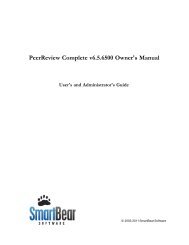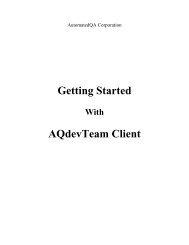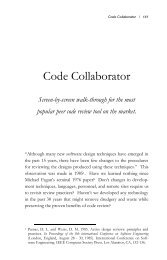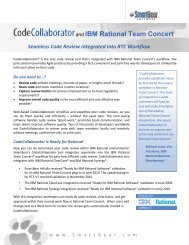Best Kept Secrets of Peer Code Review - SmartBear Support
Best Kept Secrets of Peer Code Review - SmartBear Support
Best Kept Secrets of Peer Code Review - SmartBear Support
You also want an ePaper? Increase the reach of your titles
YUMPU automatically turns print PDFs into web optimized ePapers that Google loves.
Social Effects <strong>of</strong> <strong>Peer</strong> <strong>Review</strong> / 89<br />
Social Effects <strong>of</strong> <strong>Peer</strong><br />
<strong>Review</strong><br />
Unexpected positive social aspects; handling<br />
hurt feelings, and the “Big Brother Effect.”<br />
Perhaps a manager’s most difficult task is to deal with emotions<br />
and human interactions. It’s easy to think <strong>of</strong> Vulcan-like developers<br />
having no feelings, but nothing could be further from the truth,<br />
outward appearances notwithstanding.<br />
Any criticism is an opportunity both for growth and for embarrassment.<br />
In our experience with customers and with in-house<br />
code review we’ve uncovered several social issues that managers<br />
and team-leads should be aware <strong>of</strong>. Some are positive and should<br />
be encouraged in the group; others are negative and need to be<br />
addressed in a way that is both sensitive and effective.
90 / <strong>Best</strong> <strong>Kept</strong> <strong>Secrets</strong> <strong>of</strong> <strong>Peer</strong> <strong>Code</strong> <strong>Review</strong><br />
The “Ego Effect”<br />
The first effect takes place even before the first code review<br />
happens. The ego will inflict both good and bad feelings in code<br />
review; in this case good.<br />
“Jerry always forgets to check for NULL-pointer exceptions.”<br />
No one wants to be known as the guy who always makes silly,<br />
junior-level mistakes. So imagine yourself in front <strong>of</strong> a compiler,<br />
tasked with fixing a small bug, but knowing that as soon as you say<br />
“I’m finished,” your peers – or worse your boss – will be critically<br />
examining your work.<br />
How will this change your development style? As you work –<br />
certainly before you declare code-complete – you’ll be a little more<br />
conscientious. Do your comments explain what you did and why?<br />
Did you remember to check for invalid input data? Are there a<br />
few more unit tests you could write?<br />
In other words, you become a better developer immediately.<br />
You’re going to do a great job because you want a perfect review<br />
report. “Wow,” your boss will declare in the meeting notes,<br />
“I’ve never reviewed code that was this thoughtful! I can’t think <strong>of</strong><br />
a single thing to say! Perfect!”<br />
OK, maybe not. But you want the general timbre <strong>of</strong> behindyour-back<br />
conversations to be “Oh yeah, his stuff is pretty tight.<br />
He’s a good developer” and not “He’s pretty good but makes a lot<br />
<strong>of</strong> silly errors. When he says he’s done, he’s not.”<br />
A nice characteristic <strong>of</strong> the Ego Effect is that it works equally<br />
well whether reviews are mandatory for all code changes or just<br />
used as “spot-checks.” If you have a 1-in-3 chance <strong>of</strong> being called<br />
out for review, that’s still enough <strong>of</strong> an incentive to make sure you<br />
do a great job. There is a breaking point, however. For example,<br />
if you just had a 1-in-10 chance <strong>of</strong> getting reviewed, you might be<br />
sloppier because now you have an excuse. “Yeah, I usually<br />
remember to do that. You just caught me on a bad day.”
Social Effects <strong>of</strong> <strong>Peer</strong> <strong>Review</strong> / 91<br />
This is an example <strong>of</strong> the ego working for us. Later we’ll see<br />
how the ego can result in social problems, but for now let’s stay<br />
positive and investigate a fun, productive aspect <strong>of</strong> peer code<br />
review that is rarely pointed out.<br />
Old Habits Die Easy<br />
It was our second code review at Smart Bear S<strong>of</strong>tware using an<br />
alpha version <strong>of</strong> our new code review tool. I was reviewing a small<br />
change Brandon made to some Java code. He had added the<br />
following line <strong>of</strong> code:<br />
if ( “integrate”.equals( str ) ) { ... }<br />
I stared at it for a moment. He was testing whether a string<br />
str was equal to the constant string integrate. But I would have<br />
written it the other way – with integrate and str switched. I<br />
realized both methods work, but perhaps there was a reason he<br />
picked this one?<br />
I shot him a quick message. He explained that if str is null,<br />
his way the expression will return false whereas with my way<br />
we’d have a null-pointer exception. So he’s in the habit <strong>of</strong> putting<br />
constant strings on the left side <strong>of</strong> an equals() expression like<br />
that.<br />
Good trick! A new habit I can get into that will eliminate an<br />
entire class <strong>of</strong> bugs from my code 1. I just became a slightly better<br />
developer. And I had fun doing it!<br />
Later we were talking about the review and we realized two<br />
totally unexpected things happened here.<br />
1 As a C developer I was used to the similar trick <strong>of</strong> putting numeric constants on<br />
the left side <strong>of</strong> double-equal signs in conditions, e.g. if(0==x) rather than<br />
if(x==0). This way if I accidentally used a single-equal operator the compiler<br />
would complain. The Java example is analogous, and yet somehow my brain<br />
didn’t make the connection. It just goes to show you’re never too old to learn<br />
something in computer science!
92 / <strong>Best</strong> <strong>Kept</strong> <strong>Secrets</strong> <strong>of</strong> <strong>Peer</strong> <strong>Code</strong> <strong>Review</strong><br />
First, my learning experience had nothing to do with the bug<br />
Brandon was fixing. Just the fact that we were communicating<br />
about source code meant we were also sharing knowledge.<br />
Second, I was the reviewer, yet I was the one learning something.<br />
Normally you think <strong>of</strong> the review process as unidirectional<br />
– the reviewer points out problems for the author, and the author<br />
might learn something in the process. But here I was the reviewer,<br />
and yet I was the one who was learning!<br />
This was not an isolated incident. In the next four weeks we<br />
had all learned a lot from each other – everything from programming<br />
tricks to obscure facts about the system API and virtual<br />
machine. Our collective insights were spread around quickly – far<br />
faster than any other technique we could have invented.<br />
And the best part was: It was fun! It’s just plain fun to learn<br />
something new and to grow as a developer. And it’s fun when<br />
everyone else in the <strong>of</strong>fice is learning too – it’s just as fun to teach<br />
as to learn and you get the feeling that the whole development<br />
organization is accelerating.<br />
Systematic Personal Growth<br />
It gets even better.<br />
Try this experiment sometime 2: For one week, make a log <strong>of</strong><br />
every error you make. Every misspelling in e-mail, every time you<br />
accidentally close the application you’re working in, every time you<br />
have a bug in your code, even every syntax error you make. Don’t<br />
get too specific; keep each item in the list high-level and use hash<br />
marks to count how many times you make that type <strong>of</strong> mistake.<br />
For now, just imagine you’ve done this. As you might guess,<br />
certain patterns emerge. A few <strong>of</strong> the items have an awful lot <strong>of</strong><br />
2 These ideas were inspired by the S<strong>of</strong>tware Engineering Institute’s (SEI) Personal<br />
S<strong>of</strong>tware Process (PSP). This is a collection <strong>of</strong> methods for increasing personal<br />
productivity in concrete, measurable ways.
Social Effects <strong>of</strong> <strong>Peer</strong> <strong>Review</strong> / 93<br />
hash marks next to them. In fact, by the end <strong>of</strong> the second day<br />
you might have been getting tired <strong>of</strong> counting some <strong>of</strong> them!<br />
And that annoyance might live in the back <strong>of</strong> your mind.<br />
You might even start thinking about it consciously. Pretty soon<br />
you’ll anticipate the mistake and prevent yourself from making it.<br />
Some <strong>of</strong> those will come easy, others will take work to eliminate.<br />
But eventually you develop habits that prevent that type <strong>of</strong><br />
error completely. If you frequently forget to close parenthesis in<br />
your code, perhaps you’ll enable the feature in your code editor<br />
that closes parenthesis for you. If you close applications by<br />
accident, maybe you’ll pause just a few seconds every time you’re<br />
about to hit the close button. Maybe you’ll look up how to spell<br />
common words or learn how to input your common mistakes into<br />
the auto-correct facility in your e-mail editor.<br />
Over time you become more productive, more efficient.<br />
You’re working faster and smarter. Not through some self-help<br />
seven-step program, just by observing yourself a little more<br />
carefully and systematically than you’re used to.<br />
<strong>Code</strong> review is an opportunity to do exactly this with regard<br />
to your s<strong>of</strong>tware development skills. <strong>Review</strong>ers will do the work<br />
<strong>of</strong> determining your typical flaws; all you have to do is keep a short<br />
list <strong>of</strong> the common flaws in your work. Over time, correct them.<br />
Pick a few at a time to work on. No pressure, no deadlines, just<br />
think about it sometimes.<br />
In fact, this technique works almost as well when you review<br />
your own code than when someone else reviews it. Usually you<br />
need to at least view the code in a format that isn’t your standard<br />
editor to get the problems to jump out at you, just as errors in<br />
Word documents become clear only when printed instead <strong>of</strong><br />
viewing on-screen. Indeed, many code inspection advocates insist<br />
that inspections must be done only with print-outs for this very<br />
reason.
94 / <strong>Best</strong> <strong>Kept</strong> <strong>Secrets</strong> <strong>of</strong> <strong>Peer</strong> <strong>Code</strong> <strong>Review</strong><br />
Even if employed informally and irregularly, this technique<br />
helps you become a better, more efficient developer by leveraging<br />
the feedback you’re already getting from peer review. And once<br />
again, becoming better is fun!<br />
But <strong>of</strong> course not all social aspects <strong>of</strong> code review are fun and<br />
personally rewarding. Managers should be aware <strong>of</strong> these problems<br />
and know how to mitigate them.<br />
Hurt Feelings & The “Big Brother” Effect<br />
There are two major ways in which code review adversely affects<br />
the social environment <strong>of</strong> the development team. Fortunately it<br />
turns out that one managerial technique can address both problems<br />
at once. Here we explain the two problems and give specific<br />
ways for managers to address them.<br />
First: Hurt feelings.<br />
No one takes criticism well. Some people blow up more easily<br />
than others, but everyone feels a twinge when defects are<br />
pointed out. Especially when the subject is trying his hardest,<br />
deficiencies pointed out can feel like personal attacks.<br />
Some people can handle it, correct the problem, laugh at their<br />
own foibles, and move on, where others takes things personally<br />
and retreat to their cubicle to ruminate and tend to their bruised<br />
egos.<br />
Second: The “Big Brother” effect.<br />
As a developer you automatically assume it’s true. Your review<br />
metrics are measured automatically by supporting tools. Did<br />
you take too long to review some changes? Are your peers finding<br />
too many bugs in your code? How will this affect your next<br />
performance evaluation?<br />
Metrics are vital for process measurement, which in turn is<br />
the basis <strong>of</strong> process improvement, but metrics can be used for<br />
good or evil. If developers believe their metrics will be used<br />
against them, not only will they be hostile to the process, but you
Social Effects <strong>of</strong> <strong>Peer</strong> <strong>Review</strong> / 95<br />
should also expect them to behave in a way that (they believe)<br />
improves their metrics, rather than in a way that is actually<br />
productive.<br />
Of course these feelings and attitudes cannot be prevented<br />
completely, but managers can do a lot to mitigate the problem. It<br />
can be difficult to notice these problems, so managers have to be<br />
proactive.<br />
Singling someone out is more likely to cause more problems<br />
than it solves. Even in a private one-on-one conversation it’s<br />
difficult to give any kind <strong>of</strong> advice that might temper emotions.<br />
We recommend that managers deal with this by addressing all<br />
developers as a group. During any existing meeting, take a few<br />
moments to assuage everyone at once using some <strong>of</strong> the points<br />
below. Don’t call a special meeting for this – then everyone is<br />
uneasy because it seems like there’s a problem. Just fold it into a<br />
standard weekly status meeting or some other normal procedure.<br />
These points are all ways <strong>of</strong> explaining that (a) defects are<br />
good, not evil and (b) defect density is not correlated with developer<br />
ability and that therefore (c) defects shouldn’t be shunned and<br />
will never be used for performance evaluations.<br />
1. Hard code has more defects<br />
Having many defects doesn’t necessarily mean the developer<br />
was sloppy. It might be that the code itself was more difficult –<br />
intrinsically complex or located in a high-risk module that demands<br />
the highest quality code. In fact, the more complex the code gets<br />
the more we’d expect to find defects, no matter who was writing the<br />
code.<br />
Indeed, the best way to look at this is to turn it around: If you<br />
knew a piece <strong>of</strong> code was complicated, and a reviewer said he<br />
found no flaws at all, wouldn’t you suspect the reviewer <strong>of</strong> not<br />
being diligent? If I presented this essay to an editor, even after
96 / <strong>Best</strong> <strong>Kept</strong> <strong>Secrets</strong> <strong>of</strong> <strong>Peer</strong> <strong>Code</strong> <strong>Review</strong><br />
multiple passes at self-review, and the editor had no comments at<br />
all, shouldn’t I suspect the editor <strong>of</strong> not having read the text?<br />
It’s easy to see a sea <strong>of</strong> red marks and get disheartened; your<br />
good hard work is full <strong>of</strong> flaws. But remember that difficult code<br />
is supposed to have flaws; it just means the reviewers are doing<br />
their jobs.<br />
2. More time yields more defects<br />
An interesting result <strong>of</strong> studies in code inspection is that the<br />
more time the reviewer spends on the code the more defects are<br />
found. In retrospect that might sound obvious – the longer you<br />
stare at something the more you can say about it. But the amount<br />
<strong>of</strong> time needed to find all defects is greater than you might guess.<br />
In some cases, the group tried to target a certain amount <strong>of</strong><br />
time per page <strong>of</strong> code, testing whether spending 5, 15, 30, or even<br />
60 minutes per page made a difference. Most found increases in<br />
defect densities up until at least 30 minutes per page, some even<br />
saw increases at 60 minutes per page. After a certain point the<br />
number <strong>of</strong> defects would level <strong>of</strong>f – at some point you really have<br />
considered everything you can think <strong>of</strong> – and further time spent on<br />
the code would yield no extra defects. But 60 or even 30 minutes<br />
per page is a lot more time than most people would guess.<br />
But what this also means is that the quantity <strong>of</strong> defects found<br />
in a piece <strong>of</strong> code has more to do with how much time the<br />
reviewer spent looking at the code as opposed to how “good” the<br />
code was to begin with. Just as more complex code ought to yield<br />
more defects, reviewers who spend more time on code ought to<br />
uncover more defects. And this still has nothing to do with the<br />
author’s productivity or ability.<br />
3. It’s all about the code<br />
Remind everyone that the goal <strong>of</strong> this process is to make the<br />
code as good as possible. All humans are fallible, and mistakes will<br />
be made no matter how careful or experienced you are.
Social Effects <strong>of</strong> <strong>Peer</strong> <strong>Review</strong> / 97<br />
In 1986 the space shuttle Challenger exploded 110.3 seconds<br />
after lift-<strong>of</strong>f, killing all seven crew members. The subsequent<br />
presidential investigation sought to answer two questions: What<br />
caused the explosion, and why wasn’t this prevented?<br />
The first question was answered in a famous demonstration<br />
by the Nobel Prize-winning physicist Richard Feynman 3. The<br />
answer wasn’t incredible; the rubber O-rings used to connect<br />
sections <strong>of</strong> the fuel task were inelastic at low temperatures and<br />
therefore allowed fuel to leak out the side <strong>of</strong> the tank where it<br />
subsequently ignited. The troubling part is that this wasn’t news.<br />
This was a documented, well-understood physical property. So<br />
why didn’t they cancel the launch?<br />
Suddenly the second question became much more interesting.<br />
Not just to figure out whom to blame for the debacle, but to<br />
correct systemic problems that impact the safety <strong>of</strong> all missions.<br />
It got worse. It turns out the rocket engineers did report the<br />
data that implied that launching at 29 degrees Fahrenheit was<br />
unsafe. The data were contained in a report given from rocket<br />
engineers to launch <strong>of</strong>ficials the night before the launch.<br />
So the launch <strong>of</strong>ficials were at fault for authorizing a launch<br />
when engineers had data showing it was unsafe? No, because the<br />
manner in which the data were presented completely hid the trend<br />
that predicts this effect 4. The raw information was present, but the<br />
charts were drawn and data arranged in a manner that completely<br />
obscured the key relationship between O-ring failure and launch<br />
temperature. Given that presentation, no one would have concluded<br />
the launch was unsafe.<br />
3 Feynman dunked a rubber O-ring in a glass <strong>of</strong> ice water and demonstrated that<br />
they became brittle at that temperature – the same temperature as it was at the<br />
launch.<br />
4 A fascinating description <strong>of</strong> the problem (and a solution that would have<br />
prevented this disaster) is given in Edward Tufte’s Visual Explanations: Images<br />
and Quantities, Evidence and Narrative.
98 / <strong>Best</strong> <strong>Kept</strong> <strong>Secrets</strong> <strong>of</strong> <strong>Peer</strong> <strong>Code</strong> <strong>Review</strong><br />
So the engineers were at fault for misrepresenting the data?<br />
No, because the data were correct. No one thought to re-arrange<br />
the data in a manner that would have shown the trend. No one<br />
was trained in data visualization and presentation techniques.<br />
The take-home point is this: Even with many, very intelligent<br />
and experienced people, mistakes will be made. NASA addressed<br />
this problem in nine parts, most <strong>of</strong> which are forms <strong>of</strong> review 5.<br />
The point <strong>of</strong> s<strong>of</strong>tware code review is the same – to eliminate as<br />
many defects as possible, regardless <strong>of</strong> who “caused” the error,<br />
regardless <strong>of</strong> who found it. This isn’t personal.<br />
Indeed, as a manager you know that if “quantity <strong>of</strong> defects”<br />
were used in performance evaluations, developers would have<br />
incentive to not open defects even when they know they’re there.<br />
That’s the opposite <strong>of</strong> the goal <strong>of</strong> the review process, so you know<br />
that defects must necessarily not factor into any personal – or<br />
personnel – report.<br />
Tell your developers you understand what they’re afraid <strong>of</strong>;<br />
then they’re more likely to believe that their fears are unfounded.<br />
4. The more defects the better<br />
The preceding points lead to a seemingly illogical conclusion:<br />
The more defects we find, the better. After all, if finding a defect<br />
means a Challenger disaster is averted, than finding defects is good.<br />
If we expect defects in important or complex code, finding defects<br />
in that code is good. If reviewers naturally find more defects when<br />
they’re diligent, higher numbers <strong>of</strong> defects are good.<br />
This conclusion is in fact correct! Think <strong>of</strong> it this way: Every<br />
defect found and fixed in peer review is another bug a customer<br />
never saw. Another problem QA didn’t spend time tracking down.<br />
Another piece <strong>of</strong> code that doesn’t incrementally add to the<br />
5 See the <strong>of</strong>ficial correspondence between NASA and the Presidential Commission<br />
on the Space Shuttle Challenger Accident.<br />
http://history.nasa.gov/rogersrep/genindex.htm
Social Effects <strong>of</strong> <strong>Peer</strong> <strong>Review</strong> / 99<br />
unmantainablility <strong>of</strong> the s<strong>of</strong>tware. Both developers and managers<br />
can sleep a little easier at night every time a defect is uncovered.<br />
The reviewer and the author are a team. Together they intend<br />
to produce code excellent in all respects, behaving as documented<br />
and easy for the next developer to understand. The back-andforth<br />
<strong>of</strong> code-and-find-defects is not one developer chastising<br />
another – it’s a process by which two developers can develop<br />
s<strong>of</strong>tware <strong>of</strong> far greater quality than either could do alone.<br />
The more defects that are found, the better the team is working<br />
together. It doesn’t mean the author has a problem; it means<br />
they’re both successfully exploring all possibilities and getting rid<br />
<strong>of</strong> many mistakes. Authors and reviewers should be proud <strong>of</strong> any<br />
stretch <strong>of</strong> code where many defects were found and corrected.<br />
Also, as described earlier, defects are the path to personal<br />
growth. As long as over time you’re eliminating your most<br />
common types <strong>of</strong> mistakes, defects are a necessary part <strong>of</strong> the<br />
feedback loop that makes you a better developer. So again, the<br />
more defects that are found the better; without that feedback you<br />
cannot continue to grow.
















